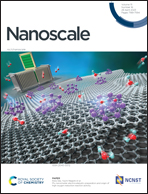KPFM visualisation of the Schottky barrier at the interface between gold nanoparticles and silicon†
Abstract
Gold nanoparticles (AuNPs) deposited on a doped silicon substrate induce a local band bending and a local accumulation of positive charges in a semiconductor. Unlike the case of planar gold–silicon contacts, working with nanoparticles results in reduced values for the built-in potential and lower Schottky barriers. Here, AuNPs of 55 nm diameter were deposited on several silicon substrates that were previously functionalized with aminopropyltriethoxysilane (APTES). The samples are characterized by Scanning Electron Microscopy (SEM) and the nanoparticle surface density is assessed with dark-field optical microscopy. A density of 0.42 NP μm−2 was measured. Kelvin Probe Force Microscopy (KPFM) is used to measure the contact potential differences (CPD). The CPD images exhibit a ring-shaped pattern (“doughnut-shape”) centred on each AuNP. The built-in potential is measured at +34 mV for n-doped substrates and it decreased to +21 mV for p-doped silicon. These effects are discussed using the classical electrostatic approach.



 Please wait while we load your content...
Please wait while we load your content...